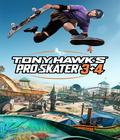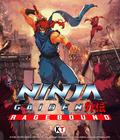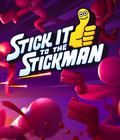The stickman is so simple that even those without artistic talent can create a good-looking one. It also happens to be the type of character that elicits joy thanks to a few videos featuring a stickman fighting others in fluid combat that would rival any Hong Kong film. A few games have tried to emulate that sort of kinetic action, and Stick It to the Stickman is the latest to give it a shot.
The demo starts your blue stickman in a hub world that gives you an idea of the different environment you'll eventually fight in. When you reach the corporate building, you learn that you're a new employee trying to climb the corporate ladder to become the big boss. In this case, it means literally fighting your way to the top.
At first glance, what you have is a 2D brawler where you need to defeat all of the enemies on a floor (or a few floors) before the elevator opens up so you can progress to the next area. You start at the bottom floor, where there's not much to work with, but things change as you head up. You'll suddenly get larger vertical space to play in as well as windows that you can knock people out of (or get knocked out of), but you respawn with a health penalty. This ends up culminating in a rooftop fight with the company CEO and a few text-based choices when you win — before making another run up the corporate ladder.
The developers have mixed some roguelike elements into the gameplay, and the elements feel quite natural. Each run through a company has randomized enemies and floor layouts, and while it takes some time to notice any changes in the level layout, you'll notice the enemies more as you go from standard brawling stickmen to more heavyset ones, minibosses with large hammers, and a few foes with guns. While fighting, you can run into randomly dropped boxes that might give you upgrades in strength or transform your moves into more powerful versions. Completing a level also opens a door where you get stat upgrades, new moves or new weapons.
Perhaps the biggest difference between Stick It to the Stickman and most other brawlers is the combat system. You only have one attack button, and you are heavily encouraged to button-mash your way to victory. However, you also have a line of different attack types at the bottom, and each hit of the attack button cycles through them all. For example, if you have a karate chop first, a box throw second, a flying kick third, and another karate chop in the fourth slot, that's exactly the order of attacks that will be executed with every press of the attack button. It means that you can't really save those projectile attacks for big fights, and you will run out of ammo since most people aren't going to be button-mashing carefully. It means that the game's controls aren't complicated, and it solves the issue of making the fights feel dynamic.
The result is exactly what you expect, as fights with all sorts of enemies retain the fluidity of those stickman fight videos. There's still an immense amount of joy in simply beating up other stickmen with a bevy of moves, while the physics system makes it enjoyable to see them collide with one another and crumble under each other's weight — or on top of lockers and crashing through boxes. There's still a sense of challenge despite the constant upgrades, as health drops are very rare to come by. The crowd density and variety mean that your best bet at survival is to play more strategically, aiming to eliminate enemies quickly via the environment as opposed to rushing through a crowd and hoping for the best. The good news is that everything you do comes in the service of unlocking new characters with default move sets and perks, so there's some incentive in making the same runs over and over, since the character types change up the experience significantly.
Even in this early stage, the game is quite playable on the Steam Deck. There are two presets for both high-end and low-end PCs, but you'll want to stick with the low-end option, as there isn't too much of a difference between them thus far. The game moves fluidly on the system, and it handles large groups of enemies quite well. The only issue at the moment is that the game averages two hours on the Deck, which seems low considering the game appearance, but that's something that will eventually get smoothed out as development progresses.
Stick It to the Stickman provides a great first impression because the fighting system feels nice. The fluidity and variety in addition to the roguelike nature create a good incentive to keep playing. It didn't feel tiresome to go through the demo a few times. We're still a year away from release, but here's hoping that Stick It to the Stickman retains the same level of enjoyment that the demo provided.
More articles about Stick It To The Stickman











 Stick It To The Stickman is a groin-kicking, staple-gunning, chainsaw-wielding roguelike brawler loaded with high-impact, physics-based combat, copious amounts of coffee and weaponized farts!
Stick It To The Stickman is a groin-kicking, staple-gunning, chainsaw-wielding roguelike brawler loaded with high-impact, physics-based combat, copious amounts of coffee and weaponized farts!






